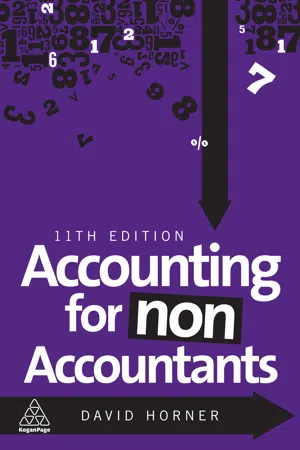
- English
- ePUB (mobile friendly)
- Available on iOS & Android
Accounting for Non-Accountants
About This Book
Accounting for Non-Accountants provides the perfect introduction to the basics of accounting and finance. Designed for non-specialists with little or no background in accounting, it guides readers through the maze of financial terms and accounting concepts and techniques in a clear and easy-to-follow style.Now in its 11th edition, Accounting for Non-Accountants includes information on the UK GAAP accounting standards as well as an overview of current international standards, and updates including a new chapter on how competition, the financial markets and government economic policy can influence organizations. The book is structured clearly to provide in-depth understanding in three key areas: annual accounts (including income statements, balance sheets, cash flow and reporting standards); management accounting (costing, marginal costing and budgetary controls); and financial management (including the cost of capital, working capital, investment appraisal and performance analysis).With updated online resources, including additional review questions for each chapter and a multiple choice question section, Accounting for Non-Accountants is ideal for beginners and provides an excellent grounding for those taking accountancy qualifications.
Frequently asked questions
Information
07
Accounting for other business organizations
Introduction
Table of contents
- Cover
- Title Page
- Copyright
- Contents
- Introduction
- 01 Financial record keeping
- 02 Income statements
- 03 The balance sheet
- 04 Further adjustments to the income statement
- 05 Checking the double-entry system
- 06 Accounting concepts
- 07 Accounting for other business organizations
- 08 An introduction to business costing
- 09 Marginal costing and decision making
- 10 Standard costing
- 11 Budgeting
- 12 Working capital management
- 13 Capital investment appraisal
- 14 An introduction to limited companies
- 15 Published accounts of the limited company
- 16 Accounting standards
- 17 Statement of cash flows
- 18 Accounting ratios
- 19 The economic environment
- Index
- Backcover